The Samsung Galaxy S6 and S6 edge Review
by Joshua Ho on April 17, 2015 9:00 AM EST- Posted in
- Smartphones
- Samsung
- Mobile
- Galaxy S6
- Galaxy S6 Edge
NAND Performance: The First UFS Phone
Storage performance is often a critical area for user performance, as applications cannot be cached in RAM at every possible moment. Camera performance is also often limited by storage performance as RAM buffers can only do so much to maintain performance before it’s necessary to commit photos to non-volatile storage.
However due to the memory hierarchy to some extent, storage performance is often hard to notice once it’s at a point where things are “good enough”. Unfortunately, in some cases we can see OEMs failing to include sufficiently performant solid-state storage, which can be a major pain point in the user experience when random read/write performance is low enough that there are noticeable IO pauses as the system has to wait for data to be loaded from storage.
The Samsung Galaxy S6 family is the first shipping implementation of UFS (Universal Flash Storage) 2.0 standard, which makes the internal storage model less like an SD card in nature. When comparing the eMMC 5.1 standard to the UFS 2.0 standard, we see a move from a the 400 MB/s maximum of the eMMC 5.1 standard with HS400 physical link interface to MIPI M-PHY, which allows for a theoretical maximum of around 720 MB/s and should be more efficient in transmitting data than the current eMMC standard. In addition, UFS makes it possible to do full duplex communication, which means that reads and writes can happen simultaneously. There's also a command queue, which helps to avoid inefficiencies that could arise from waiting for commands once a command has been processed by the storage controller, and utilizes the SCSI protocol to facilitate these new features at the interface level.
As for the Galaxy S6 itself, the UFS implementation Samsung is using is Samsung developed. Samsung's current implementation only supports up to 300 MB/s (or 2.4 Gbps) transfer rates as a theoretical maximum, so from an interface perspective it's still not reaching the full capabilities of the standard. Though even at a cap of 300MB/sec, it still stands to be a significant improvement over typical eMMC solutions.
Finally, on a technical note, the 32GB models are of the model KLUBG4G1BD-E0B1 with a maximum queue depth of 16.
In order to test storage performance, we use Androbench with some custom settings to get a reasonable idea of performance in this area, although this test isn’t an exhaustive examination of storage performance by any means.
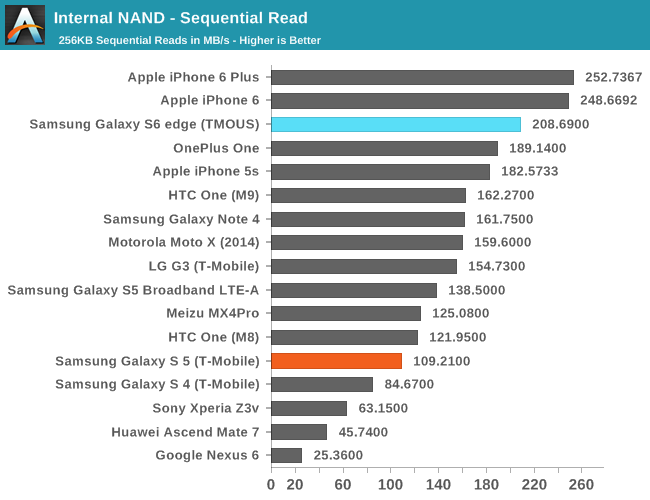
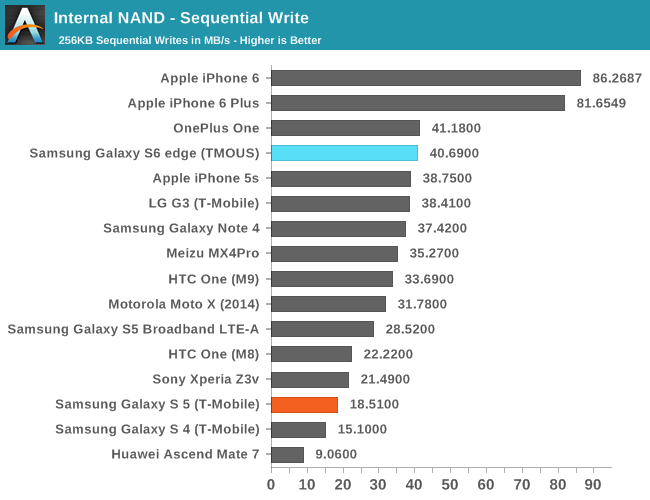
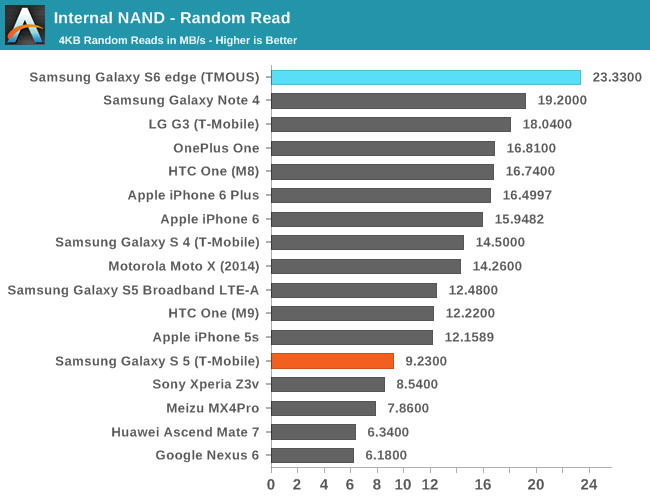
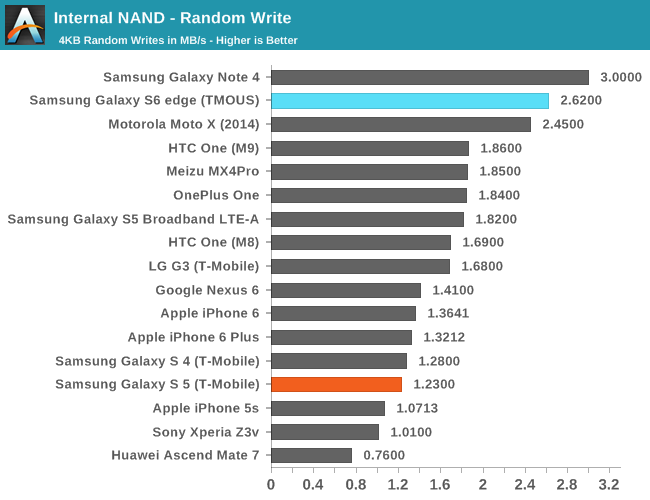
The Galaxy S6 performs rather impressively in our standard storage test, but not as fast as one might have hoped. This is due to the nature of the Androbench 3.6 test, which only tests a single IO thread, which won’t use the UFS storage of the Galaxy S6 to its full extent. In order to see the kind of difference that UFS really makes, I ran the same test again on Androbench 4.x, which does support multiple IO threads. However, as our iOS storage test and Androbench 3.6 don’t support more than a single IO thread we will continue to present both results for now.
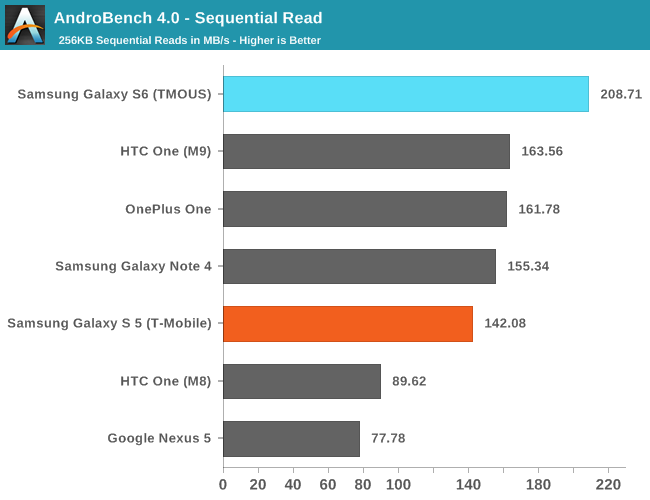
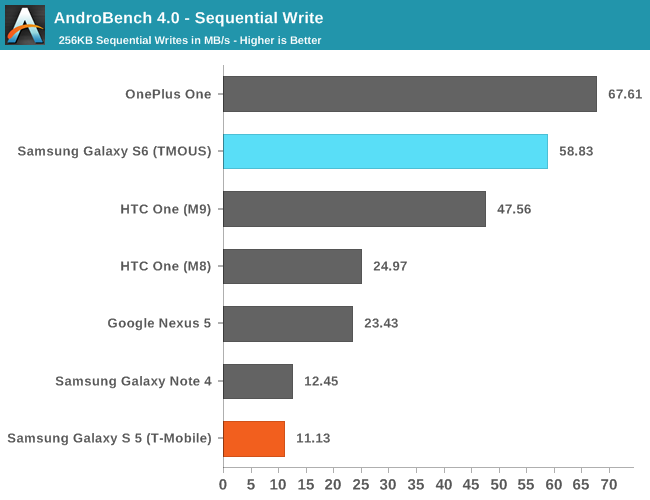
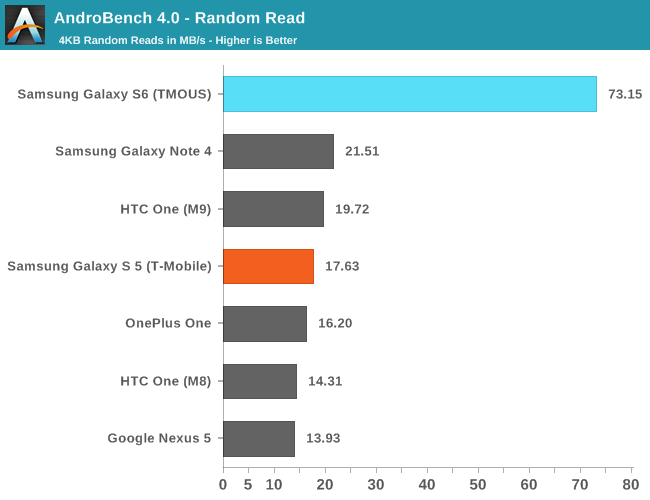
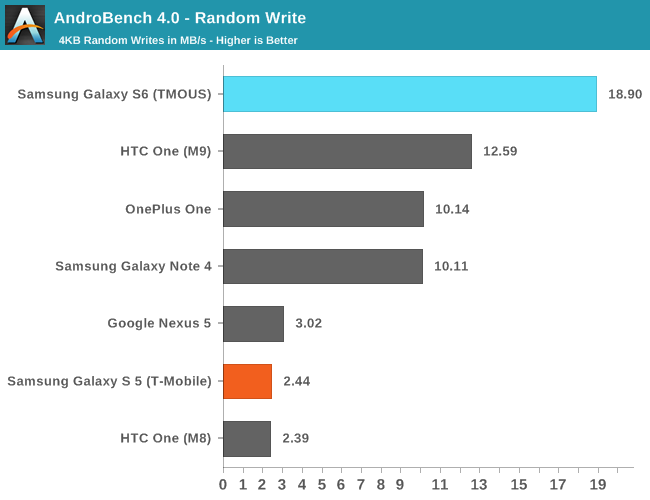
Overall, there are some immense benefits in storage performance here, especially in random IO performance. The Galaxy S6 has some of the fastest storage available in a phone today as far as I can tell given that this is basically a pure MLC solution, and shouldn’t have any real issue with storage performance holding back the rest of the phone over the course of 1-3 years as long as a reasonable amount of free space is kept to allow efficient storage management.


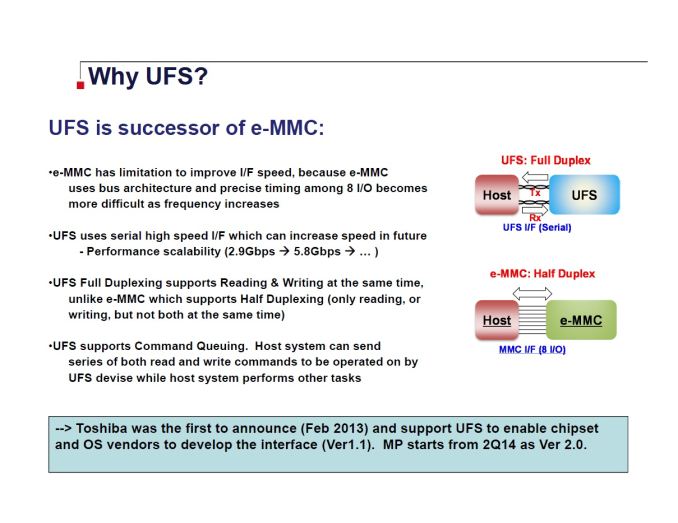








306 Comments
View All Comments
darkich - Saturday, April 18, 2015 - link
That SoC. And that storage. And that screen. And that camera. And that design and build quality...i just held this thing for the first time yesterday and was frankly smitten despite of my initial skepticism.Anyway the benchmark performance is EPIC. iPhone got thoroughly beaten throughout, (except, of course, in the on screen graphics test)
I mean this phone scores higher in Geekbench than the freaking MacBook!!!
darkich - Saturday, April 18, 2015 - link
Oh and using synthetic tests for the battery is an absolute horse sh!t of unbelievable proportions!Why just not go common sense and no horsesh!t, like the actual tests of endurance for calling, music, video playback, gaming and browsing??
According to GSMArena, the S6 scores over 11 hours of browsing and video playback, which is a GREAT result and perfectly on line with Samsung’s official slides.
akdj - Sunday, May 31, 2015 - link
So comment A= 'Epic benchmarks!'And comment B= 'Why are you using synthetic benchmarks?' (In essentially the ONLY B/M that's throttled by the competition?)
Cryio - Saturday, April 18, 2015 - link
For future smartphone reviews, please use the current photography champion, the Lumia 930, in photo comparison tests.JoshHo - Saturday, April 18, 2015 - link
I would love to include the Lumia 930 in photo comparisons if I had one.Dj Gains Bond - Saturday, April 18, 2015 - link
I have a few questions to the complainers of no removable battery and lack thereof of storage.How many times have you had to replace the battery in your s5?
How much storage were you actually buying/using?
I went from s5 to s6, Why because I'm a phone addict and I like new things.
The base s5 had 16gb while the s6 base, has 32gb. Technology moves at such a pace, either you like and use what you have or buy the newest thing. I personally don't care if it has a removable battery or storage. Heck, they have various cloud services along side the phones storage plus many other options to store things with and via the phone.
Complaining does what? Perhaps the next variants will have that but wait, at what costs. Supposedly they're making a phone with removable battery and sd card.
Sandan - Saturday, April 18, 2015 - link
Well...This is a phone I will not buy. No sd card or not being able to replace the battery is a deal breaker....Chaser - Saturday, April 18, 2015 - link
iPhones haven't had removable batteries and SD cards since creation and obviously they sell. Samsung rightfully sees that as a nitch market worth sacrificing to market a more appealing phone. Phones have all but replaced jewelry as the new social status device. People want appealing items to pull out of their pockets and display for all on the counter, table or bar. I'm sure another competitor will design a phone that will have those. So when you nerds pull out your phones you can proudly explain your joy about having a replaceable battery and SD card slots to your friends if they can stay awake that long.sevin7 - Saturday, April 18, 2015 - link
Excellent review. I have been a Samsung fan for a while but sadly the lack of removable battery and sd card ruins this phone for me. Once you put the phone in a case it looks very similar to the older plastic versions. I'm extremely irritated that consumers have led Samsung to make a phone that compromises everything for the sake of looks. It looks like the LG G4 is going to be my next phone.jrs77 - Saturday, April 18, 2015 - link
No removable battery and no mSD-slot makes this just as crap as the iPhone.I'll never buy a phone without these two critical points covered.